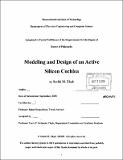Modeling and design of an active silicon cochlea
Author(s)
Zhak, Serhii M
DownloadFull printable version (20.84Mb)
Other Contributors
Massachusetts Institute of Technology. Dept. of Electrical Engineering and Computer Science.
Advisor
Rahul Sarpeshkar.
Terms of use
Metadata
Show full item recordAbstract
Silicon cochleas are inspired by the biological cochlea and perform efficient spectrum analysis: They realize a bank of constant-Q Nth-order filters with O(N) efficiency rather than O(N²) efficiency due to their use of an exponentially tapered filter cascade. They are useful in speech-recognition front ends, cochlear implants, and hearing aids, especially as architectures for improving spectral analysis in noisy environments and for performing low-power spectrum analysis. In this thesis I describe four contributions towards improving the state-of-the-art in silicon-cochlea design, two of which involve theoretical modeling, and two of which involve integrated-circuit design. On the theoretical side, I first show that a simple rational approximation to distributed partition impedances in the biological cochlea captures its essential features and enables an efficient artificial implementation achieving maximum gain in a minimum number of stages while still maintaining stability. In particular, I show that the terminating impedance of the cochlea is crucial for its stability and discuss various analytic methods for termination. Second, I derive a novel composite artificial cochlear architecture composed of a cascade of all-pass second-order filters from a first-principles analysis of the biological cochlear transmission line. The novel all-pass architecture reduces phase lag and group delay in the silicon cochlea, a problem in prior designs, sharpens its high-frequency rolloff slopes, increases its frequency selectivity, and improves its nonlinear compression characteristics. On the circuit side, I first present a novel current-mode log-domain topology that simultaneously increases signal-to-noise ratio (SNR) and dynamic range while lowering power consumption in resonant filters with high quality factor Q. (cont.) The novel topology is validated in a second-order low-pass resonant filter, which is employed in the silicon cochlea, demonstrating a reduction in power consumption and increase in SNR by a factor of Q. When bias currents in the filter are adjusted as the signal level varies, this technique enables an improvement in maximum SNR by a factor of Q and an increase in maximum non-distorted signal power and dynamic range by a factor of Q⁴. Measurements from a chip in a 0.18-[mu]m 1.1-V CMOS technology achieve a quiescent power consumption of 580-nW at a 15-kHz center frequency with a maximum SNR of 41.3dB and dynamic range of 76dB for a Q=4. Finally, I describe a current-mode -stage 0.18-[mu]m silicon cochlea that achieves 79dB of dynamic range with 41-[mu]W power consumption on a 1-V power supply over a usable 3.5kHz-14kHz frequency range. These numbers represent an 18dB improvement in dynamic range and a 12.5x reduction in power consumption over prior state-of-the-art silicon cochleas.
Description
Thesis (Ph. D.)--Massachusetts Institute of Technology, Dept. of Electrical Engineering and Computer Science, 2008. Includes bibliographical references.
Date issued
2008Department
Massachusetts Institute of Technology. Department of Electrical Engineering and Computer SciencePublisher
Massachusetts Institute of Technology
Keywords
Electrical Engineering and Computer Science.